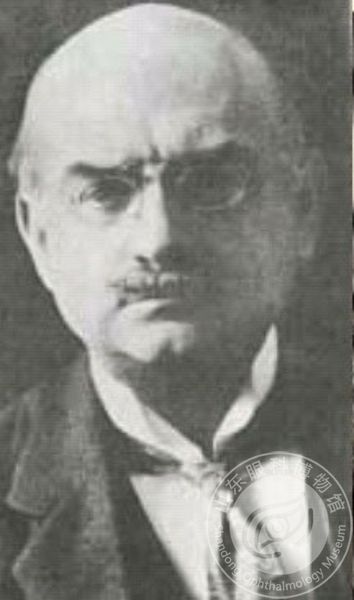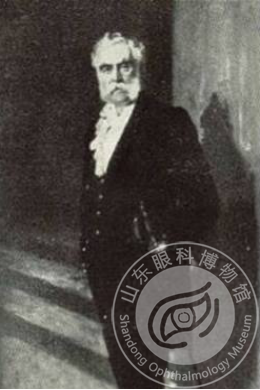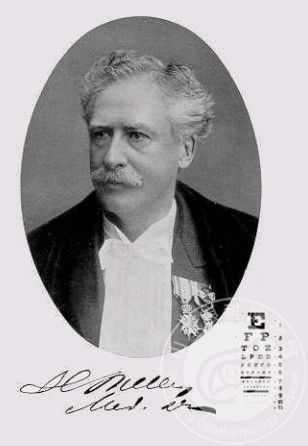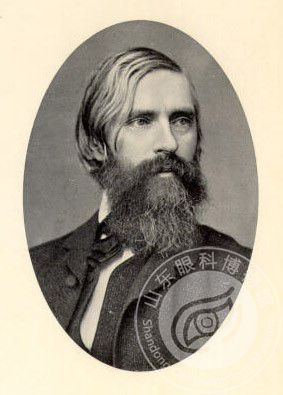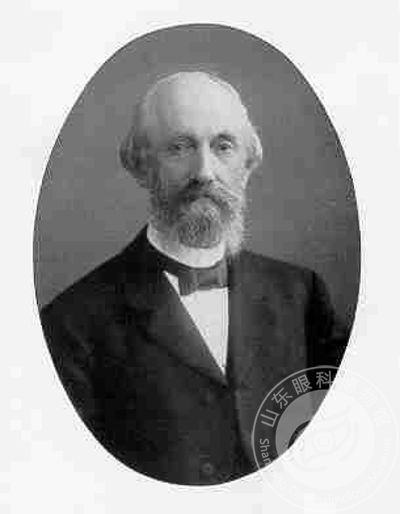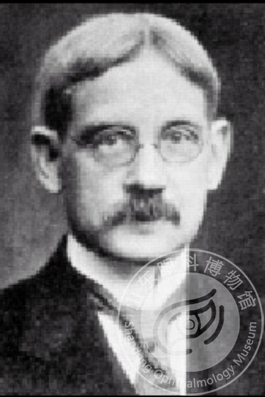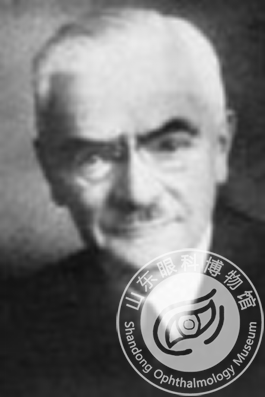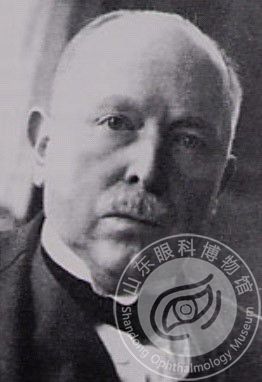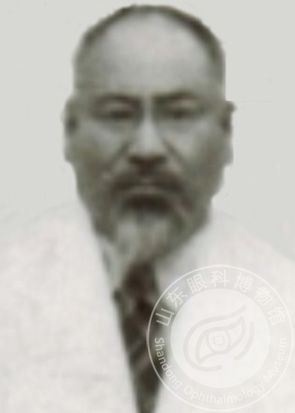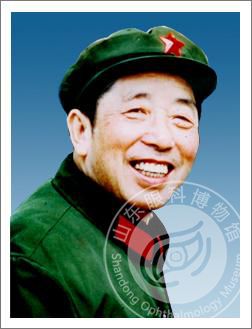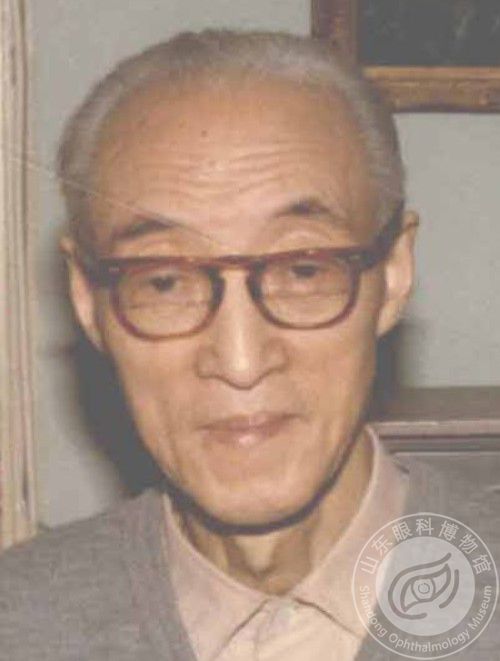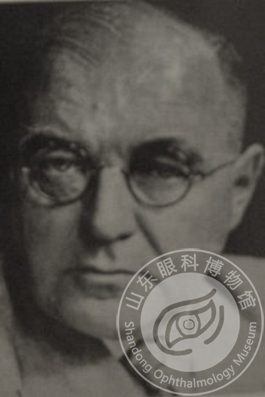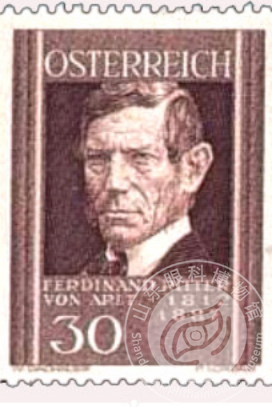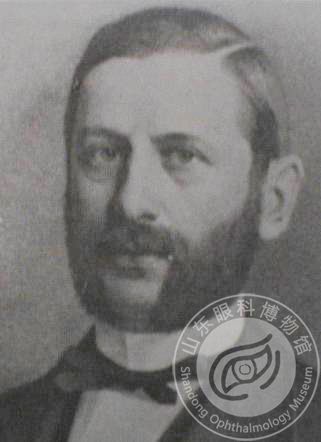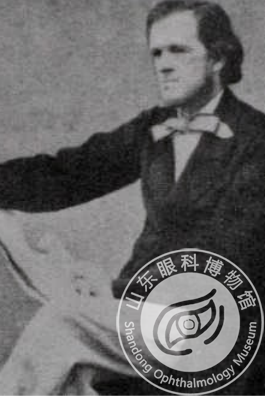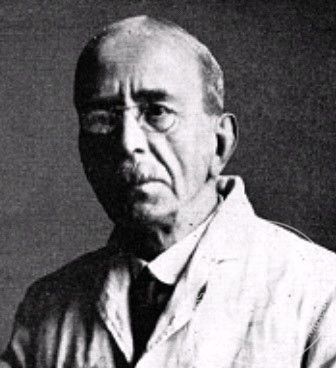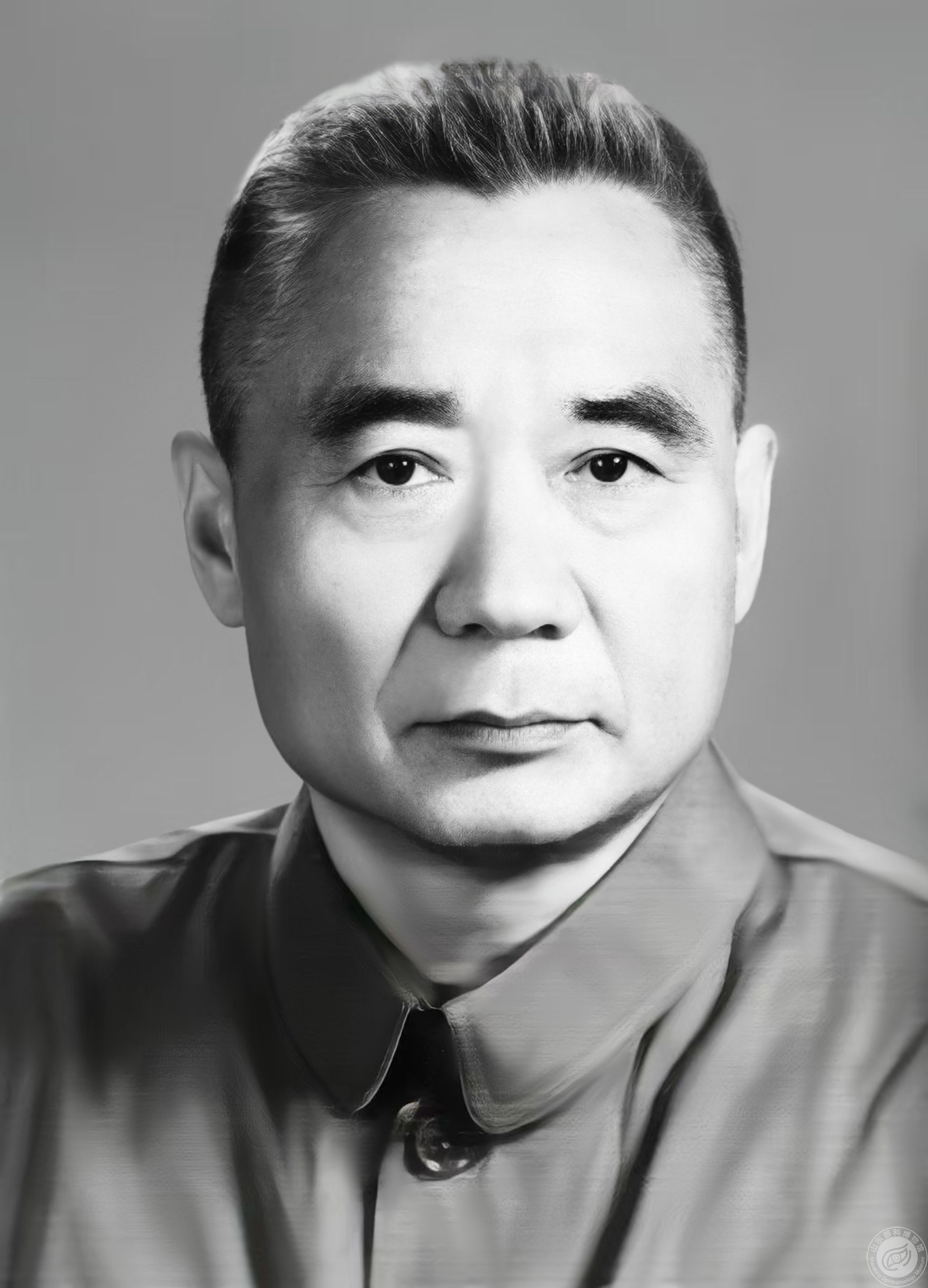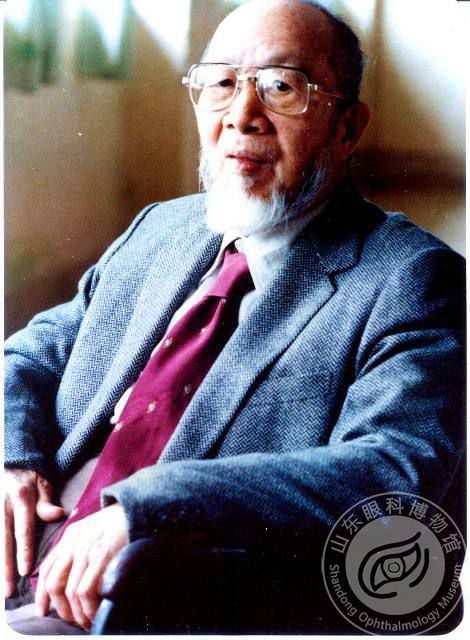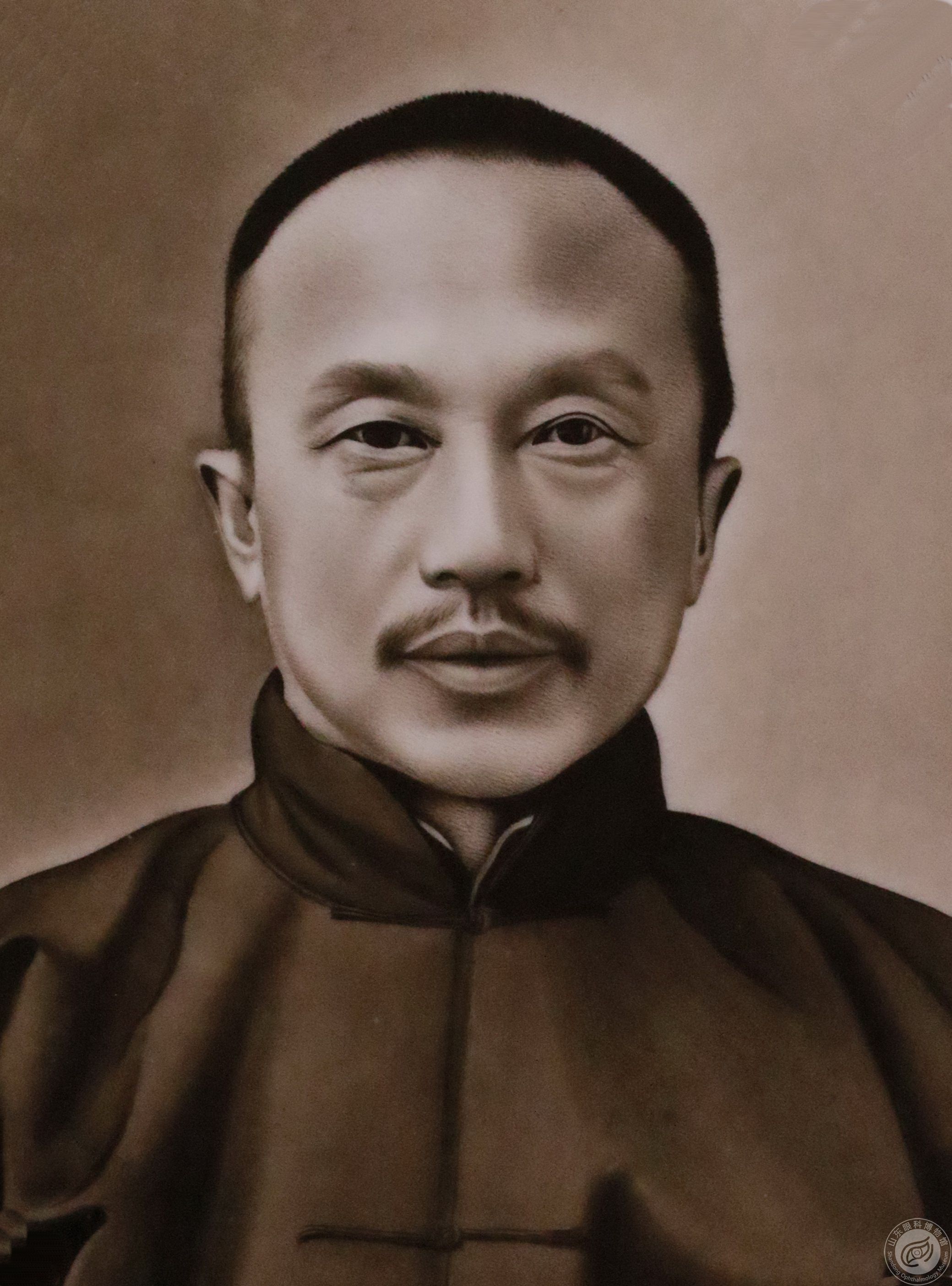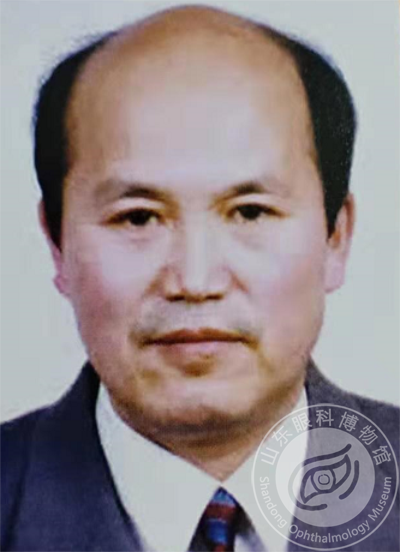Terson's syndrome = Terson described vitreous hemorrhages occurring in patients with subarachnoid hemorrhage and attributed it to a sudden increase in venous pressure that ruptures epipapillary and peripapillary capillaries. About 20% of patients suffering of subarachnoid, or subdural hemorrhages develop intraocular hemorrhages that in most cases are confined at the posterior pole. Intraretinal and subretinal bleeding may also be present, usually from the optic disc and retinal blood vessels. Subhyaloid hemorrhages are usually present. In most cases these hemorrhages clear spontaneously and vision function is unaffected.
生卒年月 1837/01/01 - 1909/01/03
Scottish ophthalmologist, born in 1837, Edinburgh; on January 3, 1909, Gonday near Mumbai, India died. Douglas Moray Cooper Lamb Argyll Robertson was one of the first surgeons to focus entirely on the ophthalmology field, and his name was always associated with the phenomenon he described in his pupil in his back. Graefe's scalpel: Designed for cataract extraction, it is now historic.
Argyll Robertson Syndrome: A common symptom of neurosyphilis, particularly back pain, and other diseases of the central nervous system where the pupil is small and slow or not responding at all, but retains response to regulation and convergence.
生卒年月 1834/02/19 - 1908/01/18
Dutch ophthalmologist, born 19th February, 1834, Zeist (Utrecht); died 18th January, 1908.
Snellen's charts = Chart printed with lines of black letters used for testing visual acuity.
生卒年月 1828/03/22 - 1870/07/20
German ophthalmologist, born on May 22, 1828, in finkenhal, Berlin, Germany (mark Brandenburg);He died in Berlin on July 20, 1870.Graefe's sign: when a patient's gaze changes from looking up to looking down, the upper eyelid cannot follow the eye downward.Graefe's knife: a historically significant knife for cataract extraction.
生卒年月 1858/09/01 - 1926/06/10
American ophthalmologist, born on September 1, 1858, Malone, New York; died on June 10, 1926.
Alexander Duane is one of the earliest researchers in the field of ophthalmology and is particularly interested in conditioning and strabismus. He is best known for the translation of the book by Ernst Fuchs, the authority of Vienna. In 1903, the book appeared in English under the name "Fox Eye Science Textbook" and has eight versions.
Duane syndrome: The adduction of the adduction and contraction of the medial and lateral rectus muscles at the same time helps to identify the condition. Duane's retraction syndrome is often mistaken for the sixth nerve paralysis in infancy because of the lack of abduction of the eye involved. In fact, Duane syndrome is common in children as a cause of limited abduction, so it is important to keep this in mind.
生卒年月 1871/12/11 - 1940/04/05
German ophthalmologist, born on December 11, 1871, died on April 5, 1940 in New York. Alfred Bielschowsky was born in a Jewish family in Namslau, Lower Silesia. He graduated in 1889 and subsequently entered medical research at the University of Breslau. He quickly moved to Heidelberg, where he graduated in 1891. In the first semester of clinical education, he was influenced by the lecture by Theodor Leber (1840-1917).
His main areas of work are the physiology and pathology of Raumsinn and the movement of the eye. He is a collaborator of Graefe-Saemisch at Handbuch der gesamten Augenheilkunde.
Bielschowsky's head tilt test: an upper oblique muscle paralysis test caused by a fourth cranial nerve injury.
生卒年月 1879/10/31 - 1943/01/01
Swiss ophthalmologist, born on October 31, 1879, in Menziken;He died in 1943.Alfred vogt studied at the university of Basel and received his doctorate in 1904.Vogt has developed techniques for retinal endoscopic examination and surgical treatment of retinal detachment.In 1913, he began examining the structure of the front of the eye using a new slit lamp and corneal microscope.Vogt is a leader in ophthalmology and has received the prestigious Donders and Gullstrand MEDALS for his work.Limbal girdle of Vogt: limbal corneal opacity bundle, an arc concentric, at 3 PM and 9 PM and corneal limbus adjacent inside palpebral fissure;Nasal infections are more common than temporary infections, but usually both.Vogt-koyanagi-harada syndrome (VKH) : systemic inflammation involving the eyes and other organs common to some RACES
生卒年月 1891/01/01 - 1966/12/31
毕华德,眼科学家、医学教育家、中国现代眼科学的主要奠基人。对眼屈光学有特殊的研究,著有《眼屈光学》 。他所建立的诊断、处理方法,至今仍为人们所遵循。对沙眼、淋病性眼炎、梅毒性眼炎以及青光眼、白内障等都有深入研究。在北京协和医院首倡用汉语讲课。他是中国第一位西医眼科医师,又将中医眼科学用英语在外文杂志上发表,以宏扬祖国医学。创建中国最早的眼科学会,并创刊《中华眼科杂志》 。
生卒年月 1916/01/01 - 2000/01/01
湖南益阳人。1935年入南京大学医学院,毕业后留校任眼科助教、讲师、代主任,1949年留学美国曾任纽约哥伦比亚大学眼科研究员,新泽西州Somesset医院住院医师。西弗吉尼亚州医院眼科主治医师。1956年毅然回国,任第四军医大学眼科副教授,教授,副主任,主任。1984年加入专家组。是首批获国家特殊津贴和早期回国定居专家津贴的人员。任《中华眼科杂志》编委,解放军眼科专业组副组长,中华医学会陕西省分会眼科学会副主任,《眼科研究》、《眼外伤与职业性眼病杂志》编委,顾问等。曾对地震性眼底压挤伤进行了细致的观察和分型,撰写科学论文进行了国际交流。指导研究的有关眼外伤的一流实验和病理学研究,获军队科技进步一等奖。译有《培顿眼科手术学》,主编《创伤眼眼科学》。
生卒年月 1908/01/01 - 1986/01/01
曹福康(1908-1986),男,浙江宁波人。眼科专家,三级教授。1935年毕业于上海圣约翰大学医学院,获医学博士学位,次年赴美国宾夕法尼亚大学医学院深造,获眼科硕士学位,并任该院眼科总住院医师。
1938年回国后,历任圣约翰大学眼科教师和宏仁医院、邮电医院、仁济医院眼科顾问等职。1956年曹福康教授响应党和政府的号召,放弃开业诊所,参加上海第二医学院工作,历任上海第二医学院儿科系眼科教研组主任,仁济医院、第九人民医院眼科主任。
1958年调任新华医院眼科主任、眼科教研室主任,为新华医院眼科的全面发展奠定基础。发表论文有“我国儿童眼肌电图”、“电烙法治疗视网膜血管瘤病”、“工业性铅中毒眼部 症状 5 例分析报告”、“中医治疗中心性视网膜炎初步报告”等。
生卒年月 1874/10/28 - 1943/01/01
German ophthalmologist, born on October 28, 1874, died in 1943.
Carl Behr studied at Freiburg, Kiel, Munich and Berlin and received his Ph.D. in Kiel in 1900. He is an intern and assistant physician at the Eppendorfer and St-George hospitals in Hamburg and the eye clinic at Keele University. In 1910, he was engaged in eye science research there. In 1916 he became an extraordinary professor in Kiel and in 1923 he was appointed professor of ophthalmology at Hamburg. His area of particular interest is neuro-ophthalmology, which depicts several new entities, including those now named after him.
Behr's optic atrophy: a recessive form of optic atrophy that may occur alone or may be associated with deafness, diabetes, and neurological complications.
生卒年月 1812/04/18 - 1887/03/07
German ophthalmologist, born on April 18, 1812, Obergraupen near Teplitz, Bohemia; died on March 7, 1887. He received ophthalmology training from Professor Johann Nepomuk Fischer (1777-1847), founder of modern ophthalmology medicine in Bohemia, and received his doctorate in medicine in Prague in 1839. From October 1846 to July 1849, he served as the chairman's supplement. Ophthalmology in Prague, August 1849 to July 1856, Professor of Ophthalmology in Prague.
At the beginning of his large-scale work on eye diseases, Arlt began his career at an early stage and in 1855 collaborated with Franz Cornelis Donders (1818-1889) to become a co-editor of Archivfür Ophthalmologie magazine.
生卒年月 1833/01/01 - 1890/01/01
Berlin neuroanatomist and psychiatrist born in 1833 died in 1890.Karl friedrich otto westphal was a renowned physician and private medical consultant.From 1851, he studied in Berlin, Heidelberg and Zurich, and received his doctorate in Vienna and Paris.In 1857 westphal became assistant to the charite smallpox branch in Berlin.A year later, he moved to the department of mental disorders as an assistant doctor.In 1861, he was appointed professor of psychiatry at the university of Berlin.In 1868, westphal became head of smallpox and internal medicine.A year later, in 1869, he was appointed distinguished professor of psychiatry, chief physician and clinical teacher of the department of psychiatry and neurological diseases, and full professor of psychiatry in 1874.Edinger-Westphal nucleus: parasympathetic nucleus of the third oculomotor nerve.
生卒年月 1849/01/01 - 1984/01/01
German anatomist. Born in Mainz in 1849, he became a lecturer at the University of Heidelberg School of Medicine in 1845. He died in 1984.
Bruch membrane: refers to a thin film-like structure between the choroidal capillary layer and the pigment epithelium of the retina. Because the first is described by Bruch, hence the name.
生卒年月 1857/11/27 - 1952/03/04
British neurophysiologist (born 27 November 1857 in London) died 4 March 1952 in eastbourne, Sussex.Sherrington completed his medical course from 1884 to 1887 and was certified by the Royal College of Physicians in 1886.In 1887, sherrington was appointed lecturer in physiology at st Thomas's medical college in London, where he continued to study the spinal cord.From 1891 to 1905, he succeeded Sir Victor Alexander haden horsley (1857-1916) as chief physician at the brown institute, the centre for the study of physiology and pathology in humans and animals.In 1895, sherrington was appointed professor of physiology at Liverpool holt.In 1932, he Shared the Nobel Prize in physiology or medicine with Edgar Douglas Adrian.Sherrington's law: reciprocal innervation law: when a group of muscles is stimulated, the opposite of the activity of the first group of muscles is inhibited.
生卒年月 1907/5/15 - 1993/2/20
陈任(1907-1993),我国著名的老一辈眼科专家。浙江奉化人。
1922年就读吴淞同济大学中学部,1927年毕业后赴德国求学。曾先后就读于德国柏林大学医学院、慕尼黑大学医学院、马尔堡大学医学院、法兰克福大学医学院,1932年德国吉森大学医学院毕业,1933年获医学博士学位。回国后在“上海眼科医院”开业。1937年任上海同济大学医学院眼科教授。12月赴广州中央军医学校任眼科主任教官。后随军医学校迁广西桂林、贵州安顺任眼科主任教官、门诊部主任及医务主任。1946年从贵州安顺回上海。任同济大学医学院眼科教授、同济大学医学院附设中美医院眼科主任兼医务主任。1947年兼任同济大学医学院后期主任、同济大学附设中美医院副院长、医务主任。同时任《大众医学》创刊常务编委。1950年10月赴武汉任中南同济医学院建校委员会常务委员。11月任汉口协和医院眼科主任(创建)。1951年9月兼任中南同济医学院副教务长。1956年11月被评为高教二级教授。1959年3月任武汉医学院第二附属医院(同济医院)眼科主任(创建)。1959年6月任武汉医学院第一届院务委员会常务委员,科研工作专门委员会主任。1975年2月至1979年12月参加《德汉医学词汇》编译组。
陈任教授曾任中华医学会眼科学会委员、湖北省暨武汉市眼科学会主任委员、顾问等职。对角膜病、沙眼病,中医眼科理论造诣尤深,发表论文30余篇约10万字。
曾任武汉市第四届人民代表大会代表,市政协第五、六届委员,中国民主同盟武汉市常委。
生卒年月 1899/01/01 - 1986/01/01
广东台山人,中国现代眼科学的主要奠基人之一,眼科学家和医学教育家。曾任中山医科大学眼科中心名誉主任,毕生从事医学教育事业,建立教育、医疗、科研与防盲的综合眼科中心,致力于中国眼科史的研究。主要论著有《眼的化学构造》、《中国眼科之外科手术》《眼科学》《中国人的屈光状况》等。
重视人才培养,教书育人,培养了我国第一批眼科研究生,主编高等院校教材《眼科学》,创办中山眼科中心,为医疗、教学、科研和防盲建立了良好基地,造就出一批眼科优秀医师。他一生勤奋、治学严谨,通晓多国浯言,发表科学论文百余篇,蜚声中外,国际视觉和眼科研究会议曾授予“特殊贡献奖”。
生卒年月 1878/12/29 - 1927/08/27
陈滋(1878-1927,字益卿,别号益钦)浙江奉化人。民国初年著名眼科医师。1901年成为浙江奉化“龙津学堂”第一届学生。1904年进入杭州同仁医学堂,1906年卒业。后在虹口同仁医院实习,在此期间他编译了《第一简明博物启蒙》、《最新种痘全书》、《病理通论》、《家畜病医治法》、《育儿全书》、《人体解剖学》、《新脉经》、《西药调制法》等一系列日本西方医学经典书籍,对清末民初的西医东渐有较大的促进作用。1910年进入东京三井慈善医院见习。1912年回上海开设眼科诊所,1915年成立“上海眼科医院”,为第一家华人眼科医师自设的眼科医院。在诊务空暇时,完成了《陈氏评批“银海精微”》一书。并撰写了《中西眼科汇通》,此书在近代眼科史上有着重要学术地位,对推动传统医学现代化作出了贡献。
出生日期 1939/01/01
褚仁远,男,1939年6月22日出生浙江天台人复旦大学附属眼耳鼻喉科医院眼科学教授,博士生导师。现任卫生部近视眼重点实验室主任、中华医学会眼科学分会常委.中华眼科学会视光学组副组长、中国医学遗传学会眼科专业委员会主任委员,为《中华眼科杂志》.《眼视光学杂志》和《中国眼耳鼻喉科杂志》副总编辑。主要从事眼科遗传病的研究,特别在近视眼的临床防治和基础研究上具有极高的造诣,是我国隐性眼镜与眼屈光手术的开拓者之一,在国内最早开展后巩膜加固术. PRK. epi-LASEK等手术,并自行研制成功国产角膜接触镜和国产LASIK. Epi-LASIK手术刀具。曾在日本国顺天堂大学医学部.日本国临床眼科研究所以及原苏联莫斯科眼显微外科研究所深造.历年来共发表论文100余篇,编著与参与编写专著20余本,曾经在世界权威杂志《Nature Genetics》上发表白内障基因的论文。曾获得的奖励有:国家技术发明二等奖(2006年),美国新英格兰视光学院国际视觉奖(2006年1、第六届香港国际眼科学术会议金奖(2006年). 第3届全球华人眼科学术大会暨中华医学会第11届眼科学术大会金钥匙” 奖(2006年)、国际现代生命科学学会(美国) 成就奖(2005年),卫生部” 突出贡献中青年医学专家”称号(1999年) 及上海市育才奖(1999年)等。
